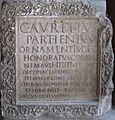Apex (diacritic) facts for kids
|
´
Apex |
||||||||||||||||||||||||||||||||||||||||||||||||||||
|---|---|---|---|---|---|---|---|---|---|---|---|---|---|---|---|---|---|---|---|---|---|---|---|---|---|---|---|---|---|---|---|---|---|---|---|---|---|---|---|---|---|---|---|---|---|---|---|---|---|---|---|---|
|
||||||||||||||||||||||||||||||||||||||||||||||||||||
|
|
||||||||||||||||||||||||||||||||||||||||||||||||||||
In written Latin, the apex is a special mark. It looks a lot like an acute accent ( ´ ). The apex was used to show that a vowel was long. This means the vowel was pronounced for a longer time than a short one.
The shape and length of the apex could change. It was usually a line sloping up to the right. Sometimes, it had a small hook pointing left. Instead of being exactly in the middle of the vowel, the apex was often drawn a bit to the right.
Over time, the apex changed into the acute accent. This accent is still used in some languages today to show long vowels. For example, you can see it in Czech, Slovak, Hungarian, and Irish.
What is the Apex?
Even though some modern Latin experts don't always notice it, the apex was used a lot in ancient times. It's often hard to spot because it's small and thin. But if you look closely in museums, you can find apices in old writings and even in handwritten documents.
Today, when people write Latin, they often use the macron to show long vowels. The macron is a flat line (¯) placed over a vowel. It was originally used to mark long syllables in poetry. This can sometimes cause confusion between a long vowel and a heavy syllable in Latin. Also, sometimes the acute accent is used in Latin to show which syllable is stressed, like in Spanish.
Apex and the Sicilicus
The apex is sometimes compared to another old Latin mark called the sicilicus. People thought the sicilicus was used over consonants to show they should be said twice.
However, one expert, Revilo P. Oliver, believed the apex and sicilicus were actually the same mark. He thought it was a "geminationis nota," meaning a mark to show that any letter should be read twice. If he was right, the apex for long vowels would have started when long vowels were written twice. Then, it changed when long vowels were no longer regularly written twice.
But other experts have recently disagreed with Oliver's idea that the two marks were the same.
See Also
Images for kids
-
Careful attention is needed to see the often extremely thin apices, as well as the sometimes minuscule difference in height of the longer I (as in fꟾliꟾ): avgvsto᷄·sacr· / a·a·lv᷄ciꟾ·a·fꟾliꟾ·men· / procvlvs·et·iv᷄lia᷄nvs· / p · s · / de᷄dica᷄tio᷄ne·decvrio᷄nibvs·et· / avgvsta᷄libvs·ce᷄nam·dede᷄rvnt. 1st century CE.
-
There are numerous abbreviations in this epitaph; in the transcription they are spelled in full in parentheses: c(aivs)·avrelivs / parthenivs / o᷄rna᷄mentꟾs·dec(vrionalibus) / hono᷄ra᷄tvs·col(oniae)·aug(ustae) / nemavsꟾ·ꟾiiiiꟾvir·avg(vstalis) / col(onia)·co᷄pia·clavd(ia)·avg(usta)·lvgvd(vnensis) / item·na᷄rbo᷄ne·ma᷄rtio / et·fir(ma)·ivl(ia)·secvnd(anorum)aravsio᷄ne / et·foro·ivliꟾ·pa᷄ca᷄to / vbyqve·gra᷄tvitꟾs·hono᷄ribvs. 1st–2nd century CE.
-
In palæographic documents, mostly written in Roman cursive, identifying the apices requires extra attention: uobis · ujdetur · p · c · decerna᷄m[us · ut · etiam] pro᷄la᷄tis · rebus ijs · ju᷄dicibus · n[ecessitas · judicandi] impona᷄tur quj · jntra᷄ rerum [· agenda᷄rum · dies] jncoha᷄ta · judicia · non · per[egerint · nec] defuturas · ignoro · fraudes · m[onstro᷄sa · agentibus] multas · aduersus · quas · exc[ogita᷄uimus]...






